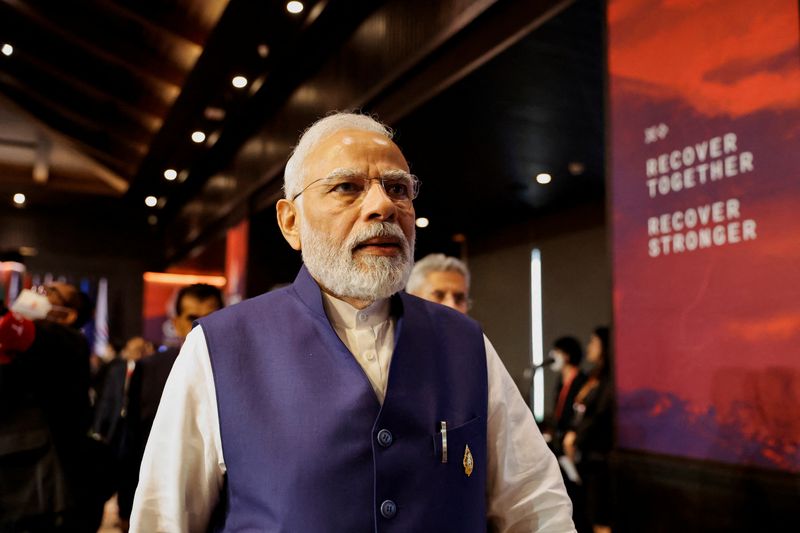(Corrects paragraphs 2 and 4 to show extra handouts were monthly)
By Aftab Ahmed and Krishn Kaushik
NEW DELHI (Reuters) - Indian Prime Minister Narendra Modi's move to effectively halve food rations to the poor ahead of state polls next year and a general election in 2024 is fiscally sound, but politically much depends on whether the charismatic leader can sell it to voters.
Subsidised food and other items are key to winning elections in India, where food aid is a legal right and more than 800 million people received an extra 5 kg of free rice or wheat a month in the last 28 months as COVID-19 ravaged their finances.
The free food programme, however, cost the government around $47 billion, worsened the fiscal deficit and reduced wheat stocks in government warehouses to multi-year lows.
From January India will end the additional 5 kg per person of food aid issued during the COVID-19 pandemic and for one year will issue 5 kg of free food each month, but reducing populist measures ahead of elections is risky.
Modi's Bharatiya Janata Party (BJP) won a record-breaking victory in his home state Gujarat this month and is widely expected to win the next general election. Analysts say that reality gives him a freer hand to impose fiscal discipline.
"It’s actually, to my mind, quite clever politics, under the circumstances of fiscal constraints," Yamini Aiyar, head of New Delhi think-tank Centre for Policy Research, said of the decision to reduce the food programme.
The government expects to save nearly $20 billion a year by ending the COVID free food scheme.
Finance Minister Nirmala Sitharaman will present the budget for the next fiscal year on Feb. 1. One government source said the move to end the COVID-era free food programme would reduce the government's subsidy burden by about 30% next fiscal year and help it rein in the fiscal deficit faster than anticipated.
The government's subsidy bill on three major items including food and fertiliser is likely to fall to under 4 trillion rupees ($48 billion) the next fiscal year, the source said, from nearly 5.5 trillion rupees in the current fiscal year that ends on March 31.
The official added that the fiscal deficit target for 2023/24 would be lower by at least 50 basis points from 6.4% this fiscal.
MODI TRUSTED BY VOTERS
Some economists had wanted the food programme gone months ago as COVID curbs eased. The government said last week that the programme would end in December, replaced by subsidised food under a pre-COVID law which will become free for one year.
India's poor are guaranteed food under a decade-old law that enshrines it as a right.
"Reduction of effective food allocation per person from 10 kg to 5 kg is clearly non-populist," said Subhash Chandra Garg, who retired as India's finance secretary three years ago.
"But, this additional food allowance was clearly not required for meeting the calorific requirement. Therefore, if you can sell the idea that poor people will be getting what is required for meeting their true food needs, i.e. 5 kg per person free of cost, possibly the negative effect can be neutralised."
Modi is known to be a master of communicating the message he wants to send voters and is helped by the fact that there is no obvious challenger to him in the country, said Yashwant Deshmukh, founder of polling agency CVoter Foundation.
Modi's approval rating is about 60%, compared with about 20% for his nearest competitor, Rahul Gandhi of the main opposition Congress party, CVoter data shows.
"I think Modi has been carrying out the majority of his decisions thanks to his trustworthiness and popularity," CVoter founder Yashwant Deshmukh said, referring to moves like banning high-value currencies in 2016 that caused widespread distress but he still won many elections easily after that.
"It's because people do not doubt his intention. Had the trust not been there, and for any other leader, it would have been difficult to end such a food programme ahead of elections."
But senior BJP leader and former minister Ravi Shankar Prasad said that the decision to reduce food aid should not be linked to elections or politics.
"This started when COVID was there. In Narendra Modi’s government, inclusion and empowerment of poor are important elements," he said.
FOOD SUBSIDIES
Elections are due in nine states in 2023 before the national poll a year later. In the last general election, a free housing and cooking gas for the poor programme helped the BJP trounce Congress.
Changes to the food handout will mean the government's total subsidies on food, fertiliser and fuel will come down by 30% to under 4 trillion rupees ($48.27 billion) next fiscal year, two government sources said.
One of the sources expect the government to reduce the fiscal deficit by at least 50 basis points to 5.9% of GDP in the fiscal year starting April 1. The second one said the food subsidy could fall to around 2 trillion rupees next fiscal year from nearly 3.2 trillion in the current year.
Pronab Sen, formerly India's chief statistician, said that had the COVID food programme been extended, government warehouses would have run out of grain closer to the general election.

"It would have been much more damaging to have to stop it in 2024," Sen said.
($1 = 82.8750 Indian rupees) (This story has been corrected to say that extra grain handouts were monthly in paragraph 2 and 4)
